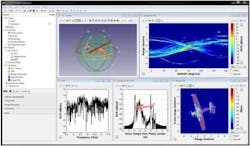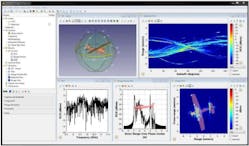CHAMPAIGN, Ill., 15 Feb. 2013. Delcross Technologies announce the first commercial release of its Signa software toolkit for advanced radar signature analysis.
Signa delivers efficient electromagnetic (EM) simulation of complex radar cross sections (RCS) for targets that are tens to thousands of wavelengths in size. In addition to RCS, Signa generates range profiles and inverse synthetic aperture radar (ISAR) images of targets, useful for identification of significant target scattering features.
The Signa graphical user interface (GUI), available for Windows or Linux, provides a framework with a logical and ordered workflow from target model import to analysis output and visualization, says a company representative. The software operates on detailed 3D CAD models of candidate targets. The surfaces of the 3D CAD models can be defined as a combination of metal, absorbers, and layered material coatings.
Visually rich data displays include overlays of the target CAD model so that results are easily interpreted in the context of the target orientation. Range profile plots (including angle vs. range) can be displayed in waterfall and donut plot formats, also with CAD model overlay for clarity. External RCS data can be imported for plotting, visualization, and comparison to simulated results.
The EM analysis engine in Signa is based on an advanced formulation of the shooting-bouncing-ray (SBR) computation technique. SBR is a proven asymptotic EM solution for RCS analysis of very large targets, and Delcross has expanded the SBR implementation to include physical optics (PO) first bounce and geometric optics (GO) blockage, extension to multi-bounce physics, curved surface ray divergence correction and physical theory of diffraction (PTD) edge radiation effects. Signa’s engine utilizes parallel processing on multi-core CPUs to accelerate solutions on a standard desktop computer.
For applications involving very complex targets and a high number of aspect angles, a cluster computing version of Signa is available for Linux computing clusters utilizing MPI.
Signa Version 1.0 is available to customers under International Traffic in Arms Regulations (ITAR) restrictions. Signa is available for Windows and Linux operating systems.
Headquartered in Champaign, IL, Delcross Technologies is a CAE software company specializing in commercial solutions for installed antenna performance, RF cosite EMI analysis, and advanced radar signature prediction.




